Fe3O4-based PLGA nanoparticles as MR contrast agents for the detection of thrombosis
- PMID: 28223802
- PMCID: PMC5310639
- DOI: 10.2147/IJN.S123228
Fe3O4-based PLGA nanoparticles as MR contrast agents for the detection of thrombosis
Abstract
Thrombotic disease is a great threat to human health, and early detection is particularly important. Magnetic resonance (MR) molecular imaging provides noninvasive imaging with the potential for early disease diagnosis. In this study, we developed Fe3O4-based poly(lactic-co-glycolic acid) (PLGA) nanoparticles (NPs) surface-modified with a cyclic Arg-Gly-Asp (cRGD) peptide as an MR contrast agent for the detection of thrombosis. The physical and chemical characteristics, biological toxicity, ability to target thrombi, and biodistribution of the NPs were studied. The Fe3O4-PLGA-cRGD NPs were constructed successfully, and hematologic and pathologic assays indicated no in vivo toxicity of the NPs. In a rat model of FeCl3-induced abdominal aorta thrombosis, the NPs readily and selectively accumulated on the surface of the thrombosis and under vascular endothelial cells ex vivo and in vivo. In the in vivo experiment, the biodistribution of the NPs suggested that the NPs might be internalized by the macrophages of the reticuloendothelial system in the liver and the spleen. The T2 signal decreased at the mural thrombus 10 min after injection and then gradually increased until 50 min. These results suggest that the NPs are suitable for in vivo molecular imaging of thrombosis under high shear stress conditions and represent a very promising MR contrast agent for sensitive and specific detection of thrombosis.
Keywords: cyclic Arg-Gly-Asp peptide; iron oxide; magnetic resonance imaging; poly(lactic-co-glycolic acid); thrombosis.
Conflict of interest statement
Disclosure The authors report no conflicts of interest in this work.
Figures

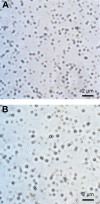
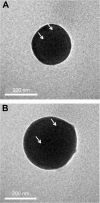
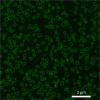
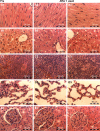


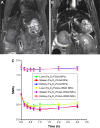
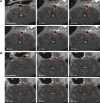

Similar articles
-
Construction and evaluation of Fe₃O₄-based PLGA nanoparticles carrying rtPA used in the detection of thrombosis and in targeted thrombolysis.ACS Appl Mater Interfaces. 2014 Apr 23;6(8):5566-76. doi: 10.1021/am406008k. Epub 2014 Apr 2. ACS Appl Mater Interfaces. 2014. PMID: 24693875
-
Preparation and characterization of gadolinium-loaded PLGA particles surface modified with RGDS for the detection of thrombus.Int J Nanomedicine. 2013;8:3745-56. doi: 10.2147/IJN.S49835. Epub 2013 Oct 1. Int J Nanomedicine. 2013. PMID: 24124363 Free PMC article.
-
Design of PLGA based nanoparticles for imaging guided applications.Mol Pharm. 2014 Nov 3;11(11):4100-6. doi: 10.1021/mp5002747. Epub 2014 Sep 29. Mol Pharm. 2014. PMID: 25225751
-
The effect of nanoparticle properties, detection method, delivery route and animal model on poly(lactic-co-glycolic) acid nanoparticles biodistribution in mice and rats.Drug Metab Rev. 2014 May;46(2):128-41. doi: 10.3109/03602532.2013.864664. Epub 2013 Dec 5. Drug Metab Rev. 2014. PMID: 24303927 Review.
-
High spin Fe(III)-doped nanostructures as T1 MR imaging probes.Wiley Interdiscip Rev Nanomed Nanobiotechnol. 2023 Mar;15(2):e1858. doi: 10.1002/wnan.1858. Epub 2022 Oct 17. Wiley Interdiscip Rev Nanomed Nanobiotechnol. 2023. PMID: 36251471 Review.
Cited by
-
Safety and efficacy of PLGA(Ag-Fe3O4)-coated dental implants in inhibiting bacteria adherence and osteogenic inducement under a magnetic field.Int J Nanomedicine. 2018 Jun 28;13:3751-3762. doi: 10.2147/IJN.S159860. eCollection 2018. Int J Nanomedicine. 2018. PMID: 29988768 Free PMC article.
-
Ultrasound-Triggered Microbubbles: Novel Targeted Core-Shell for the Treatment of Myocardial Infarction Disease.ACS Omega. 2023 Mar 14;8(12):11335-11350. doi: 10.1021/acsomega.3c00067. eCollection 2023 Mar 28. ACS Omega. 2023. PMID: 37008126 Free PMC article.
-
Iron Nanoparticles Open Up New Directions for Promoting Healing in Chronic Wounds in the Context of Bacterial Infection.Pharmaceutics. 2023 Sep 15;15(9):2327. doi: 10.3390/pharmaceutics15092327. Pharmaceutics. 2023. PMID: 37765295 Free PMC article. Review.
-
Nano-Medicine for Thrombosis: A Precise Diagnosis and Treatment Strategy.Nanomicro Lett. 2020 Apr 20;12(1):96. doi: 10.1007/s40820-020-00434-0. Nanomicro Lett. 2020. PMID: 34138079 Free PMC article. Review.
-
Recent advances and future prospects of iron oxide nanoparticles in biomedicine and diagnostics.3 Biotech. 2018 Jun;8(6):279. doi: 10.1007/s13205-018-1286-z. Epub 2018 Jun 1. 3 Biotech. 2018. PMID: 29881657 Free PMC article. Review.
References
-
- Whinna HC. Overview of murine thrombosis models. Thromb Res. 2008;122(Suppl 1):S64–S69. - PubMed
-
- Bender YY, Pfeifer A, Ebersberger HU, et al. Molecular cardiovascular magnetic resonance: current status and future prospects. Curr Cardiol Rep. 2016;18(5):47. - PubMed
-
- Wu W, Wang Y, Shen S, et al. In vivo ultrasound molecular imaging of inflammatory thrombosis in arteries with cyclic Arg-Gly-Asp-modified microbubbles targeted to glycoprotein IIb/IIIa. Invest Radiol. 2013;48(11):803–812. - PubMed
MeSH terms
Substances
LinkOut - more resources
Full Text Sources
Other Literature Sources
Medical

